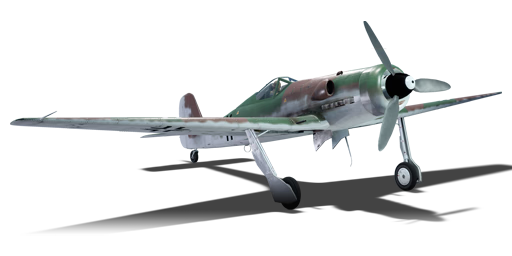



The German Air Ministry needed a high-altitude fighter to counter the Allied bombing campaigns. Kurt Tank, a notable German engineer, developed the Ta 152 which was heavily based upon the existing Fw 190 "Dora" series of aircraft. Three variants of the Ta 152 were developed but the H variant was the high-altitude fighter needed to defend German skies from bombers. Elements of the 190 Dora's airframe are clearly present on the 152 H such as the fuselage but the wings were elongated and the fuselage was stretched. In addition, the Jumo 213E engine utilized methanol-water injection (MW-50) as well as GM-1 boost. Coupled with the two-stage supercharger, the Ta 152 H could reach an impressive 755 km/h (472 mph) and an exceptional service ceiling of 14,500+ metres (47,000+ feet). This was a significant improvement over the Fw 190 D-9 and was one of the fastest propeller-driven aircraft of World War Two.
Present since the start of the Open Beta Test prior to Update 1.27, the Ta 152 H-1 is an exceptional fighter for its battle rating, largely due to its excellent manoeuvring energy retention, airspawn, and speed. Although designed for high-altitude operation, the 152 H can hold its own at lower altitudes due to the MW-50 system, GM-1 boost, and good turn rate especially with flaps. The Ta 152 H-1 also has hard-hitting cannons: two 20 mm wing-mounted MG 151s, and one 30 mm MK 108 mounted through the propeller hub.
flaps
flaps
flaps
brake
| Belt | Belt filling | Armor penetration (mm) at a distance: | |||||
|---|---|---|---|---|---|---|---|
| 10 m | 100 m | 500 m | 1000 m | 1500 m | 2000 m | ||
| HEI-T/I | 6 | 6 | 6 | 6 | 6 | 6 | |
| HEI-T/HEI-T/HEI-T/HEF-I | 4 | 4 | 4 | 4 | 4 | 4 | |
| HEI-T/HEI-T/HEI-T | 4 | 4 | 4 | 4 | 4 | 4 | |
| HEI | 4 | 4 | 4 | 4 | 4 | 4 | |
| Belt | Belt filling | Armor penetration (mm) at a distance: | |||||
|---|---|---|---|---|---|---|---|
| 10 m | 100 m | 500 m | 1000 m | 1500 m | 2000 m | ||
| IT/IT/APHE/HEI | 21 | 19 | 8 | 3 | 1 | 1 | |
| IT/HEI/HEI/AP-I | 27 | 24 | 14 | 7 | 3 | 2 | |
| AP-I/HEI/HEI/HEI/HEI/IT | 27 | 24 | 14 | 7 | 3 | 2 | |
| APHE/APHE/APHE/IT | 21 | 19 | 8 | 3 | 1 | 1 | |
| FI-T/FI-T/FI-T/IT/IT | 21 | 19 | 8 | 3 | 1 | 1 | |
| HEI/HEI/HEI/APHE/AP-I | 27 | 24 | 14 | 7 | 3 | 2 | |












Flight performance | |
|---|---|
Survivability |
|---|
Weaponry | |
|---|---|